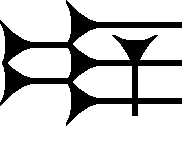
The cuneiform sign for tur is used to denote one syllabic usage, tur, or the sign's Sumerograms; it is used in the Epic of Gilgamesh and the 14th century BC Amarna letters. The sign is based on the i (cuneiform) sign, with the one small added vertical stroke.
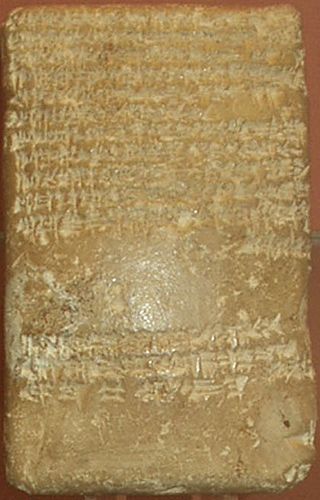
The cuneiform Ne sign, is found in both the 14th century BC Amarna letters and the Epic of Gilgamesh. In the Amarna letters, it is especially used in the opening, and introductory paragraph of the clay tablet letter, when addressing the Pharaoh (King), or when sent to another individual who is part of the Pharaoh's correspondence, for the alternate syllabic usage of "bil",. In the Amarna letters, it is used as Bil (cuneiform), for the spelling of speaks, or "says", in the opening statement; the Akkadian language word is "qabû", for to say, tell.
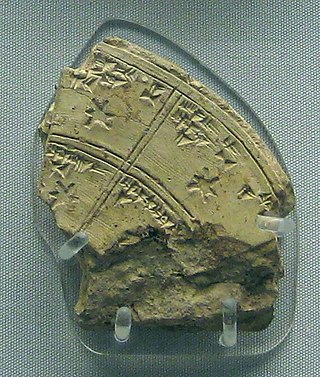
The cuneiform sign 𒀀 for a, and in the Epic of Gilgamesh the sumerogram A, Akkadian for mû, "water", which is used in the Gilgamesh flood myth, Chapter XI of the Epic, or other passages. The sign is also used extensively in the Amarna letters.

The cuneiform Ri sign, or Re, is found in both the 14th-century BC Amarna letters and the Epic of Gilgamesh; it is in the top 25 most used cuneiform signs for ri, or re, but has other syllabic or alphabetic uses, as well as the Sumerogram usage for RI.

The cuneiform U sign is found in both the 14th century BC Amarna letters and the Epic of Gilgamesh. It can be used for the alphabetic u, instead of the more common 2nd u, (ú). It has two other uses, commonly. It can be used for the number 10, but its probable greater use is for the conjunction, u, with any of the conjunction meanings: and, but, else, etc.
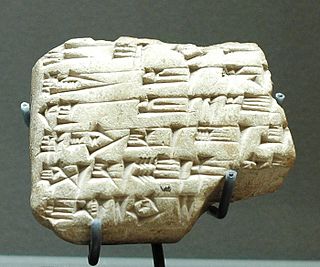
The cuneiform ia sign 𒅀, is a combined sign, containing i (cuneiform) ligatured with a (cuneiform); it has the common meaning in the suffix form -ia, for the meaning of "-mine". In the Amarna letters, the letters written to the Pharaoh of Egypt, the Pharaoh is often referenced as "Lord-mine", or especially: King-Lord-mine: "My King, My Lord". In Akkadian, the form is "Šarru-Bēlu-ia"-(King-Lord-mine), since the spelling in some Amarna letters is sometimes ŠÁR-RI for Šarru,.

The cuneiform DAGAL sign, which is a capital letter (majuscule) Sumerogram with the Akkadian language meaning of to be wide, or extensive; also "many", Akkadian "rapāšu", is a minor usage cuneiform sign used in the Amarna letters and the Epic of Gilgamesh. An equivalent usage sign for DAGAL is used in the Amarna letters, gáb, for Akkadian language "gabbu", and is found in such letters as EA 362, EA 367, and others. Gáb has other syllabic values, which are used for separate Akkadian word components.

Cuneiform sign nu is a common use syllabic, or alphabetic. It is restricted to "nu", but in the Epic of Gilgamesh, or elsewhere has a Sumerogram use NU, and probably mostly for a component in personal names (PN), god's names, or specialized names for specific items that use Sumerograms.

The cuneiform ù sign, is found in both the 14th century BC Amarna letters and the Epic of Gilgamesh. Its use is as a conjunction,, but rarely it is substituted for alphabetic u, but that vowel u is typically represented by 'u, no. 2',, ú; occasionally 'u, no. 1',, ,, is also substituted for the "alphabetic u".

The cuneiform sign LÚ is the sign used for "man"; its complement is the symbol for woman: šal. Cuneiform LÚ, is found as a Sumerogram in the Epic of Gilgamesh. It also has a common usage in the 1350 BC Amarna letters as the Sumerogram for "man".

The cuneiform mi, sign is a distinctive sign in the wedge-stroke group, and is used as a syllabic for mi, me, and an alphabetic for m, i, or e; it is also a Sumerogram for MI, used for Akkadian language, "mūšu", night. MI, in the Epic of Gilgamesh, is used in (Chapters) Tablets I, II, III, and XII as either MI, or MI.MEŠ, a total of six times; other spellings of mūšu in other sections are alphabetic/syllabic, four times.

The cuneiform ŠEŠ sign, as a capital letter (majuscule), is a Sumerogram for Akkadian language ahu, for "brother". It is the cuneiform sign for ŠEŠ, as it can be used for a variety of lower case syllabic values, using š + vowel + š,. Sumerogram ŠEŠ has a high usage in the mid-14th century BC, ~1350-1330 BC Amarna letters from the brother kingdoms to the Pharaoh's Egypt. The brother kingdoms were Babylon, Alashiya, and Mittanni, where King Tushratta authored 13 El Amarna letters.

The cuneiform bi sign, also pí, and used for other syllabic forms, as well as a sumerogram, is a common use syllabic and alphabetic cuneiform sign used in both the mid-14th century BC Amarna letters and the Epic of Gilgamesh. In the Amarna letters, it is sometimes used for the spelling of the archers, 'pí-t(x)-t(x)', an often requested need from the Pharaoh in the vassal state sub-corpus of the letters.

The cuneiform ha sign comes in two common varieties in the 1350 BC Amarna letters. It is also found in the large 12-chapter (Tablets I-XII) work of the Epic of Gilgamesh. Cuneiform ha is used as a syllabic for ha, and an alphabetic for h, or a; from the Epic of Gilgamesh it also has two sumerogramic uses (capital letter (majuscule)), for HA (Akkadian language zittu, for "share"), and KU6, for nūnu, "fish".

The cuneiform bad, bat, be, etc. sign is a common multi-use sign in the mid 14th-century BC Amarna letters, and the Epic of Gilgamesh. In the Epic it also has 5 sumerogram uses. From Giorgio Buccellati 'comparative graphemic analysis', of 5 categories of letters, the usage numbers of the bad sign are as follows: Old Babylonian Royal letters (71), OB non-Royal letters (392), Mari letters (2108), Amarna letters (334), Ugarit letters (39).

ARAD, is the capital letter-(majuscule) Sumerogram for the Akkadian language word "ardu", for servant. It is used especially in the introduction to the Pharaoh: for example "To King, Lord-mine, message thus Xxxxxx, "Servant-yours"-(271). It is also used extensively in Amarna letter texts, the author, usually the "man of a city",, where there is a constant reminder that he is a "servant", or "servant-yours"-(of the Pharaoh). Many letters are giving city-state status reports, but many are also requesting help with the Egyptian army troops-(Archers, supplied by the Pharaoh).

The cuneiform an sign, is a common, multi-use sign, a syllabic for an, and an alphabetic sign used for a, or n; it is common in both the Epic of Gilgamesh over hundreds of years, and the 1350 BC Amarna letters, and other cuneiform texts. It is also used for the designation of a "god", and is sometimes represented as a superscript: d, or capitalized: D, for "dingir", English language, "god". The example photo at right shows, a list of 14 named gods, all with "an"; the first pair on the list AN-UTU, or DUTU, refers to the "sun-god", using Ud (cuneiform), as the sumerogram, namely UTU.

The cuneiform sign tu, and for TU-(the Sumerogram, capital letter, in the Hittite language and other cuneiform texts, is a common-use syllabic sign for tu, and also with a syllabic use for "t", or "u". It is not a multi-use sign, with other alphabetic sub-varieties.

The cuneiform sign ib, is a common-use sign in the Epic of Gilgamesh, the Amarna letters, and other cuneiform texts. Its common usage is syllabic for ib, or alphabetic for i or b/p; the "i" is also exchanged for "e" when spelling specific words in the Akkadian language. Cuneiform ib also can be found as sumerogram URTA,, and for example it is used in the Epic of Gilgamesh for the god's name: Ninurta, spelled DNIN.URTA.

The cuneiform di sign, also de, ṭe, ṭi, and sumerograms DI and SÁ is a common-use sign of the Epic of Gilgamesh, the 1350 BC Amarna letters, and other cuneiform texts. In the Akkadian language for forming words, it can be used syllabically for: de, di, ṭe, and ṭi; also alphabetically for letters d, ṭ, e, or i. Some consonant-pairs (d/t), are also interchangeable.
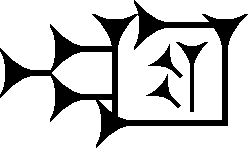

, with various positionings of two wedge-strokes
at the left, sometimes approximately centered, or often inscribed upwards to the left, the second wedge-stroke (or 'angled line-stroke'), occasionally inscribed/ligatured upon the first. The wedge-strokes can have any size, are often smaller than the vertical, but as an example, Amarna letter EA 256, can be almost as large as the vertical.
















